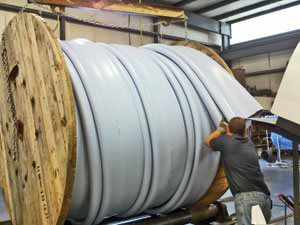Fold-And-Form 101
What Differences Can a Pre-manufactured Fold-and-Form Pipeliner Make?
Wei (Zack) Zhao, Ph.D., P.E. — Mar 23, 2011
Fold-and-form pipeliners are manufactured in a folded shape, then are thermoformed inside the pipe being rehabilitated. Fold-and-form pipelines are one of many tools in the trenchless pipe rehabilitation toolbox. Every tool in the toolbox is unique in its own right.
Fold-and-form pipeliners, as one of the primary close-fit pipe rehabilitation technologies, have many features to distinguish it from all other technologies. Among these, the most distinctive feature is that fold-and-form pipeliners are pre-manufactured.
Plastic pipe has been around for decades and has been one of the dominant piping materials. The upstream of a fold-and-form pipeliner production line is identical to most plastic pipe extrusion lines. Differences are in the downstream. A normal plastic pipe needs to be in circular shape and cut into short sections (13 to 20 ft are common lengths); fold-and-form pipeliners are intentionally flattened, or folded to other shapes (H or C), if necessary. The pipeliners in diameters 3 through 30 in. are then coiled on reels into much longer sections, normally several hundred linear feet. Polyvinyl chloride (PVC) has been selected as a preferred fold-and-form pipeliner material for more than 25 years. PVC fold-and-form pipeliners comply with ASTM F1784, which serves as the material standard. Compound with a cell classification in accordance with ASTM F1784 is provided as the raw material for a PVC fold-and-form pipeliner manufacturing plant.
Besides the raw material standard, Fold-and-form pipeliners have to comply with their product standards, ASTM F1871 and ASTM F1504. The product standard defines the requirements of materials, size, wall thickness and marking. Furthermore, these ASTM standards cover quality assurance/control (QA/QC) test methods and requirements.
Factory-mass production is the outcome of the industrial revolution. The development of modern industry has proved that standardized production, under a controlled environment, is the key to higher quality and lower cost products. Even onsite activities are inevitable in the field of construction; the use of pre-manufactured parts, such as timbers, concrete slabs, steel beams and columns, has become a routine practice for decades.
Taking direct-burial piping construction as an example, it is obviously beyond imagination for today’s contractor to build a pipe onsite unless there is a very special application. In the rehabilitation of underground pipes, there are major challenges faced during the construction of a pipe within a pipe: confined space operations, limited accesses, excessive long sections, numerous field variables, inadequate field inspection technologies, even onsite quality assurance samples are difficult to collect. For these reasons, it is more advantageous to use a pre-manufactured pipeliner to take advantage of the benefits a product manufactured under controlled environment can offer.
Fold-and-Form Pipeliners Provide Superior Quality Assurance
The industry consensus ASTM product standards (ASTM F1871 and ASTM F1504) were established in the late 1990s. The ability to confirm the compliance to the quality and physical properties of a fold-and-form pipeliner prior to and after installation permitted the creation of such product standards. The pipeliner is manufactured in environmentally controlled facilities where the design properties are established under ASTM required QA/QC protocols. Furthermore, onsite installation variables, such as ambient temperatures, processing temperature and pressures, installation schedules, groundwater exposures, etc., cannot alter the pre-established material properties. Consequently, the “as-constructed” pipeliner material properties are pre-established in the environmental controlled manufacturing process, which is a significant progress in quality assurance level achieved in the pipe rehabilitation industry.
Fold-and-Form Pipeliners Simplify Installation
Because the decisions of construction crews cannot alter the “as-constructed” design compliance of a pre-manufactured fold-and-form pipeliners, the construction process is less complex. Crews can be trained to consistently and successfully install PVC pipeliners within 10,000 to 15,000 ft of installations. Local construction companies using local labor can be trained to immediately be available to install PVC pipeliners with limited risk of disruption or added expense to the end-user and the community.
For example, in Istanbul, Turkey, after completing just one week of field installation training, a completely inexperienced local Turkish crew with their own equipment, worked with the oversight of a trainer to install a fold-and-form pipeliner above the Binbirderek Cistern, which is a World Heritage Site. This was possible, because of the simplicity of the process and the extremely low risk of a construction failure, even with an inexperienced “crew-in-training.”
Fold-and-Form Pipeliners Are Environmentally Benign
The environmental impact during and after pipeliner installation has become a rising concern in the pipe rehabilitation industry. Thermoformed pipeliners have no noxious or caustic chemicals and do not contain volatile organic compounds (VOCs), such as styrene, that are human and environmental health concerns.
In fact, the compounds used within thermoformed pipeliners are all recognized as safe for use in potable water applications. Current research at the University of Virginia stated that pre-manufactured fold-and-form pipeliners “are not expected to have any significant adverse environmental impact” and “are environmentally benign.”
Wei (Zack) Zhao Ph.D., P.E., is research director of Ultraliner Inc. at Oxford, Ala.

